Business leaders readily recognize the pivotal role of data-driven research in fostering success and problem-solving. However, a persistent gap hinders the effective utilization of Business Intelligence (BI) strategies. The journey to comprehend and optimize company performance hinges on tangible numerical insights.
When ETL BI tools are required? Envision yourself as a dedicated financial analyst within a thriving investment firm. Your mission: unravel the intricacies of a rapid portfolio shift involving prized assets. Beyond conventional number-crunching, your role encompasses data harmonization and interpretation drawn from diverse sources—stakeholder profiles, market sentiment, global economics, earnings timelines, and intricacies of asset allocation.
In this landscape, ETL business intelligence tools emerge as a solution — Extract, Transform, Load processes gather data from a spectrum of sources. Transformations enhance data, which is then loaded into a data warehouse for meticulous analysis. This assures data accuracy, consistency, and accessibility — pivotal for informed decision-making. Specialized software products aid BI specialists in executing these functions.
Before delving into a comparison of business intelligence tools, let’s briefly elucidate the ETL model and its components. Of course, these processes demand specific skills and expertise.
Suppose you seek adept assistance in BI ETL tools integration and configuration for your business data analysis. In that case, the Forbytes data engineering team stands ready to expedite these activities and implement business intelligence tools seamlessly.
Contact us today for comprehensive insights and deeper ETL tools comparison in the context of your specific requirements.
Introduction to ETL Workflow
In a manner akin to an orchestra, Business Intelligence (BI) conducts a symphony comprising activities, tools, and an infrastructure that elegantly molds unprocessed data into a vivid canvas of graphs and insights. Visualize the ETL business intelligence workflow as a chain of sequential phases, seamlessly interwoven:
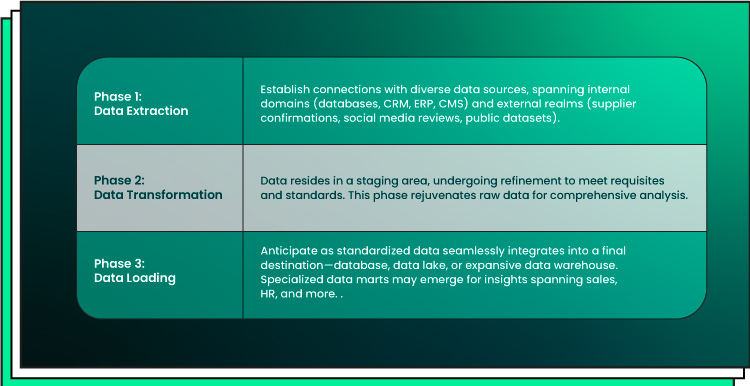
Once Phase 3 concludes and all data seamlessly converges into a unified repository, the stage is set for comprehensive research and analysis, encompassing AI-enhanced applications and ML-based data-processing operations and visualization. This involves delving deep into information and presenting outcomes through captivating visuals, facilitated by an elegant user interface.
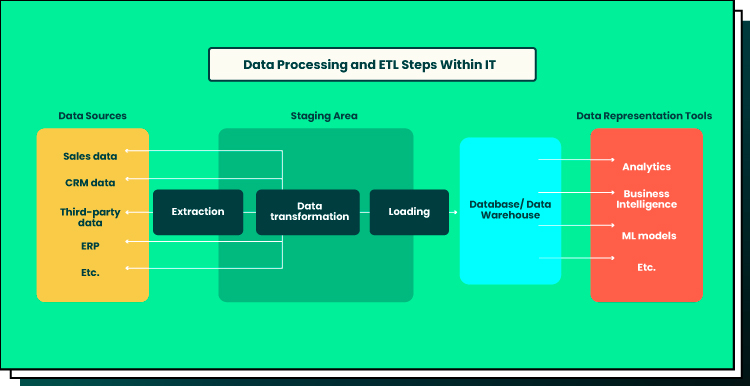
Factors to Consider When Choosing an ETL Tool
Let’s delve into two distinct scenarios:
- Complete BI infrastructure requirement. If you want to establish a comprehensive business intelligence tool set from the ground up, your focus should gravitate toward providers offering all-encompassing analytical solutions. Seek those that bundle ETL modules, data warehousing services, data analysis capabilities, and visualization tools. This holistic approach ensures a seamless synergy across every facet of your BI endeavor.
- Custom BI development objective. Perhaps you possess a talented team of tech experts capable of constructing a custom business intelligence ETL platform or segments thereof. If your pursuit lies in assembling building blocks for a tailored solution, turn your attention toward libraries, frameworks, and tools with API capabilities. These tools should possess the prowess to execute various data processing steps, aligning perfectly with your custom BI aspirations.
When navigating the landscape to select the optimal ETL tool for your organization, meticulous consideration of several pivotal factors is very important:
- Data volume. Gauge the tool’s prowess in managing the volume of data that courses through your organization. While some tools excel with smaller datasets, others are honed for formidable large-scale operations.
- Integration capabilities. Delve into the tool’s ability to seamlessly connect and integrate with a diverse spectrum of data sources. This encompasses databases, cloud services, APIs, and flat files, ensuring a unified data ecosystem.
- Performance and scalability. Scrutinize the BI ETL tool’s performance dynamics across varying load conditions and its ability to gracefully scale to accommodate future growth spurts.
- Ease of use. Intuitive design and user-friendly interfaces hold significant sway, particularly within organizations sporting diverse skill sets within their data teams. A tool that can be harnessed with ease facilitates widespread adoption and productivity.
- Data security. Uncompromising data security and adherence to industry regulations form the bedrock of responsible data management. Prioritize tools that sport robust security features, safeguarding data privacy and regulatory compliance.
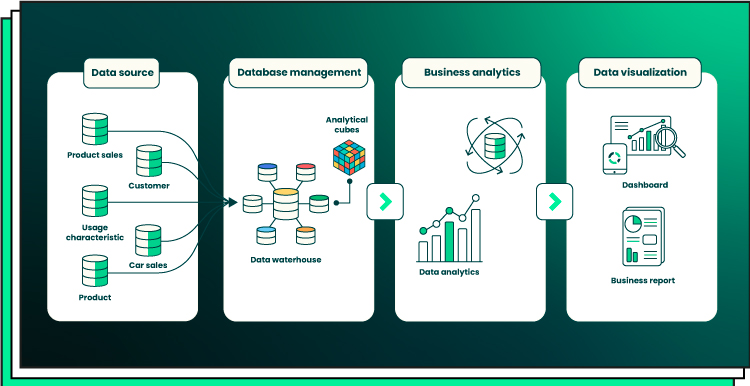
A Closer Look at Popular ETL Tools
Let’s explore business intelligence tools comparison, each with its own strengths and weaknesses:
#1. Apache NiFi
Our lineup features a variety of ETL BI products, including two from Apache. Let’s start our examination with Apache NiFi (followed by Apache Spark). Launched in 2016, Apache NiFi acts as an open-source data processing and distribution system, with a robust user base of 2400+ companies.
Boasting adaptability for on-premise and cloud usage, spanning Linux, Mac, and Windows, Apache NiFi is distinguished by its user-friendly visual interface. Ideal for intuitive ETL endeavors, it excels in real-time data integration, effectively managing complex routing and transformation tasks.
Apache NiFi stands out in data transformation, encompassing filtering, sorting, and aggregating, as well as advanced functions like joins, unions, and lookups. Though effective with large datasets, its performance may slightly taper with exceptionally massive ones.

#2. Talend
Talend is a cloud-based platform that offers seamless cloud and on-premise integration solutions. Its offerings include Talend Open Studio, an open-source tool, and the comprehensive Talend Data Fabric suite. This suite combines data integration, quality, and governance into a single, user-friendly low-code platform.
Founded in 2005, Talend serves a wide clientele, including prominent names like Toyota and eBay. It offers pre-built integration templates, a rich array of components, and an intuitive drag-and-drop interface for ease of use. Collaboration is facilitated for data integration and management projects.
Talend prioritizes data security with certifications including CCPA and GDPR compliance. While some find its interface intuitive, there are varied user opinions, and occasional performance concerns have been reported.
#3. Informatica
Informatica, an iPaaS platform serving enterprises, has been delivering ETL, ELT, and comprehensive solutions since its inception in 1993. Boasting a clientele of 5000+ companies, including Dolby and Twitch, Informatica excels in catering to the cloud and on-premise integration needs. Notable offerings encompass PowerCenter and Intelligent Data Management Cloud.
The platform welcomes users with a free entry point, requiring a work email for registration. Featuring a user-friendly low-code, no-code GUI tool and Claire AI recommendation engine, Informatica’s usability garners mixed reviews. Informatica is dedicated to data privacy, holding certifications such as SOC 2, HIPAA, and GDPR.
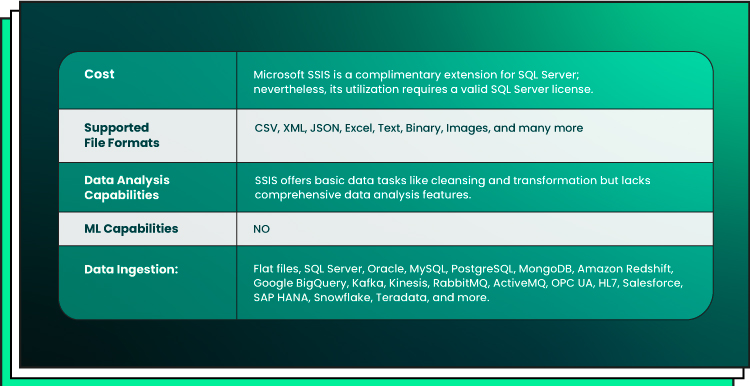
#4. Microsoft SSIS (SQL Server Integration Services)
Microsoft SQL Server Integration Services (SSIS) is a robust platform that drives efficient Data Integration and ETL solutions, serving a diverse clientele of over 100,000 businesses, including industry leaders like IBM, Ford, and Johnson & Johnson. Handling more than 10 million data transformations annually, SSIS excels in data extraction, transformation, loading, and workflow management.
With extensive source connectivity, streamlined project management, high customizability through extensions, and user-friendly deployment, SSIS empowers developers to enhance productivity by reusing scripts across projects. This comprehensive toolkit is essential for managing SQL Server objects, data handling, file operations, warehousing, cleansing, mining, and complex business tasks, making it a crucial asset for businesses seeking adaptable data integration solutions.
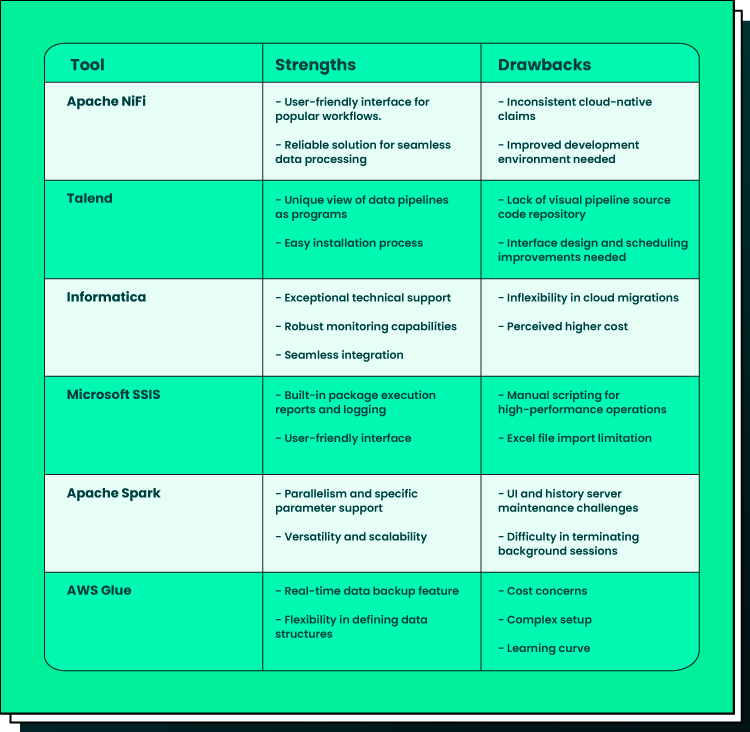
#5. Apache Spark
Apache Spark stands as a leading unified analytics engine, excelling in large-scale data processing and ETL. With a robust client base of over 1,000 companies, including industry giants Netflix and Uber, Spark’s reputation is solid. Its impressive ETL capabilities manage intricate datasets with in-memory processing and parallel computation.
Spark’s open-source nature fosters a dynamic user and developer community, enhancing versatility for diverse data tasks. From handling sources to cleansing, transforming, and loading, Apache Spark’s ETL prowess is unmatched. For potent and reliable ETL tasks, Apache Spark is a powerful choice.

#6. AWS Glue
AWS Glue, a cloud-native ETL service by Amazon Web Services, stands as a robust option for seamless data integration. Its serverless architecture ensures scalability and cost-efficiency, making it an appealing choice. With a substantial user base spanning over 100,000 clients, including prominent names like Netflix and Airbnb, AWS Glue boasts industry recognition. The service excels in its seamless integration with various AWS offerings, proving particularly advantageous for organizations immersed in cloud operations.

Matching ETL Tools to Use Cases
When selecting an ETL tool, it’s imperative to tailor your choice to specific use cases and industry demands. Here are key considerations:
- Real-time analytics. For dynamic data processing and analysis, prioritize ETL tools like Apache NiFi and Apache Spark known for real-time prowess.
- Data warehousing. Building or maintaining a data warehouse necessitates ETL tools capable of diverse data source ingestion and transformation into warehouse-friendly formats. Informatica and Talend excel in this arena.
- Cloud environments. Operating in a cloud-centric setup? Opt for ETL tools optimized for such environments, with AWS Glue serving as a prime example.
- Legacy systems. Integration with on-premises legacy systems calls for ETL tools with the expertise to navigate these landscapes. Microsoft SSIS is a reliable choice.
Additionally, account for these factors:
- Data scale and complexity
- Budget considerations
- Team proficiency and experience
Ultimately, the ideal ETL tool hinges on your unique prerequisites. If uncertain, seek guidance from data and software engineers or ETL experts to ensure your choice is a perfect fit.
Weighing the Pros and Cons: ETL Tools Comparison
Each ETL tool presents its unique advantages and challenges. Here, we provide a BI tools comparison based on their pros and cons:
Apache NiFi:
Strengths:
- User-friendly interface, effortlessly constructing popular workflows and automated processes.
- Nice visual appeal, ease of use, and straightforward implementation.
- Stands as a reliable and robust solution for seamless data processing and distribution.
- Its ability to support scalable directed graphs further solidifies its position as an outstanding choice for ETL tasks.
Drawbacks:
- NiFi’s cloud-native claims face inconsistency after testing.
- Streamlining workflows requires an improved development environment and local tool integration.
- NiFi may not fit companies with few data sources, limited processing, real-time needs, or specific demands.
- Managing NiFi at scale is challenging; duplicating pipelines demands manual settings recreation.
- Lengthy SQL queries lack automatic text field adjustment, making manual intervention necessary and task management within NiFi challenging.
Talend:
Strengths:
- Notable differentiation lies in the unique ability to view data pipelines as programs, enhancing transparency and control.
- Talend Open Studio’s easy installation, requiring only Java setup, streamlines the onboarding process.
- Talend’s exceptional support for lookups stands out, aiding in efficient data integration.
- Talend’s adept API integration and big data approach facilitate seamless extraction from diverse sources, including JSP files and MongoDB repositories.
Drawbacks:
- Absence of a visual pipeline source code repository, although integration with Git is possible.
- The interface in Talend Open Studio falls short, demanding improved documentation and enhanced graphical design.
- Scheduling capabilities are lacking in the sister version, requiring the paid cloud version for full functionality.
- Troubleshooting errors is difficult, posing challenges in the debugging process.
Informatica:
Strengths:
- Exceptional technical support.
- Robust monitoring capabilities.
- A comprehensive approach to ETL workflow construction, and a stable, scalable enterprise-scale solution.
- Seamless integration with various systems, structured and semi-structured alike.
Drawbacks:
- Inflexibility in cloud migrations.
- Perceived high cost.
- Challenging licensing.
- Limited customization for Integrations compared to similar solutions.
Microsoft SSIS:
Strengths:
- Built-in package execution reports and customizable logging enhance visibility and efficiency.
- The solution is easy to use and developer-friendly, making it accessible to various team members.
- Data flows support a wide range of scenarios, from simple source-to-sink ETL to complex multi-source, multi-sink dataflows.
- The product’s straightforward setup process streamlines initial implementation.
- SSIS offers improved performance compared to certain alternative methods, reducing manual work and enhancing efficiency.
Drawbacks:
- High-performance operations like push-down join & lookup SQL require manual database scripting or SQL Tasks, impacting efficiency.
- Importing Excel files to SQL Server is hindered by a 255-column limitation, causing challenges in data transfer.
- Certain essential capabilities like bulk delete, update, and upsert may require purchasing costly add-ons.
- While functional, SSIS’s performance could be enhanced through upgrades.
Apache Spark:
Strengths:
- Simple preparation of parallelism in Spark, combined with specific parameters, yields commendable performance.
- A wealth of functionalities enhances versatility and possibilities.
- Remarkable scalability and speed, particularly well-suited for big data tasks, outperforming earlier solutions like Informatica.
- Spark SQL’s compatibility with standard SQL eases coding, whether using APIs or direct SQL code.
- A standout feature is Spark’s distributed computing ability to efficiently distribute workload across multiple nodes.
Drawbacks:
- The UI and history server maintenance can be cumbersome, affecting user experience. Simplifying history server setup and integration is needed.
- Terminating Spark sessions running in the background can be difficult due to D allocation issues.
- The ongoing debate about programming languages might not align with personal preferences, such as disliking Scala.
- Large, intricate tasks experience slow performance due to sluggish garbage collection processes.
- The installation process is not user-friendly, posing challenges for setup.
AWS Glue:
Strengths:
- Notable real-time data backup capability enhances data security and protection.
- Leveraging a NoSQL foundation, Glue offers distinct advantages over other tools like IIS and ISAs.
- The solution empowers organizations to define data structures with increased flexibility.
- Glue’s straightforward and uncomplicated nature ensures ease of use and implementation.
- The solution’s technical support promptly addresses user issues and concerns.
- AWS Glue’s serverless architecture eliminates infrastructure worries, allowing a focus on core tasks.
Drawbacks:
- AWS Glue is expensive, posing affordability concerns for users.
- Setting up the solution can be intricate and challenging.
- The tool requires a learning curve, potentially impacting ease of adoption.
- The mapping area and data catalog functionality have room for enhancement.
- Further optimizing serverless job execution time would improve performance.
- Lack of features for streaming data hinders versatility compared to batch processing.
- Users proficient in Java or Python can leverage the product fully, while those without coding skills might find it challenging to use.
Here’s a final summary of the business intelligence ETL system comparison:

Key Considerations and Evaluation Tips When Selecting Business Intelligence ETL Products
When embarking on the journey of selecting an ETL tool, it’s imperative to deliberate upon these critical considerations and evaluation tips:
Scalability of ETL tools
In the ever-evolving data landscape, scalability reigns supreme. Opt for an ETL tool that aligns seamlessly with your data volume and accommodates future growth projections. It should robustly handle the influx of data without compromising performance or efficiency.
Bridging data sources
A pivotal aspect of an ETL tool’s efficacy lies in its integration prowess. Thoroughly scrutinize its ability to seamlessly connect with a spectrum of data sources and seamlessly bridge them to your chosen destination platforms. An optimal tool should be the enabler of harmonious data flow across diverse environments.
Cost and licensing of ETL products
Beyond the surface, delve into the depths of cost and licensing implications. Ascertain the total cost of ownership, encompassing licensing fees, requisite support, and potential infrastructure expenditures. This holistic financial assessment guarantees that your choice aligns harmoniously with budgetary constraints.
ETL software community and support
The vitality of community and support cannot be overstated. Navigate the labyrinth of ETL tools with an astute focus on the available resources, vibrant online communities, and the responsiveness of official support channels. A robust support ecosystem ensures that you’re never left grappling with challenges alone.
Emerging Trends in ETL and Data Transformation
As technology evolves, new trends in ETL and data transformation have emerged:
- ELT (Extract, Load, Transform). This approach involves loading raw data into a target system before performing transformations. It leverages the processing power of modern data warehouses for efficient transformations.
- Data streaming. Real-time data streaming and processing have gained prominence, enabling organizations to process and analyze data as it’s generated.
Conclusion
Choosing the right ETL tool is crucial for harnessing valuable insights. Each tool comes with unique strengths and limitations, catering to diverse needs. Factors such as scalability, integration, performance, and security should be carefully assessed to ensure an informed decision.
However, not all business managers may have the expertise to fully evaluate the array of information about ETL software. That’s where we come in to help. Explore seamless integration and professional ETL operations with Forbytes’ skilled data engineers.
Contact us today for a free consultation.

Our Engineers
Can Help
Are you ready to discover all benefits of running a business in the digital era?

Our Engineers
Can Help
Are you ready to discover all benefits of running a business in the digital era?







